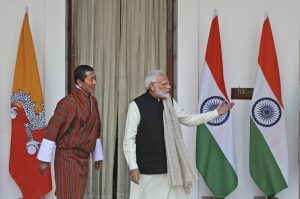New satellite images reveal that a Chinese village built around 9 kilometers east of the Doklam plateau is now fully inhabited, India’s NDTV reported last week. In addition to this village, which the Chinese have named Pangda, construction of another village in the Amo Chu river valley is almost complete, and work on a third village located farther south is progressing.
Pangda village “lies squarely within Bhutanese territory,” according to NDTV. The images also reveal an “all-weather carriageway” near the village, which runs along the banks of the Amo Chu river and 10 km into Bhutanese territory.
The images, which were captured by MAXAR Technologies, a U.S.-based company that is engaged in space technology and intelligence, lay bare an “extensive land grab” by the Chinese in Bhutan, the NDTV report says.
Although neither the village nor the road is inside Indian territory, New Delhi should be worried as these have serious implications for India’s security.
The road will give China access to the strategic Jhamperi Ridge in the Doklam plateau and “a direct line-of-sight to India’s sensitive Siliguri corridor” or “Chicken’s Neck,” a narrow tract of land that connects India’s northeastern states with the rest of the country.
The Doklam plateau in western Bhutan is claimed by both China and Bhutan. India backs Bhutan’s claim. China’s interest in this plateau stems from its strategic value. Control over Doklam will give Beijing a “major terrain advantage” over India.
The Chinese have been attempting to construct a road to the Jhamperi Ridge and in the past India was successful in preventing this.
In June 2017, for instance, Indian soldiers blocked a road the People’s Liberation Army was building to Jhamperi. It set off a tense 73-day standoff between the Indian Army and China’s PLA. Under an agreement reached on August 28, 2017, the two sides agreed on an “expeditious disengagement of border personnel at the face-off site at Doklam.”
However, India has been less successful in preventing the Chinese advance to the ridge since then.
While China did indeed pull back troops and bulldozers from the face-off site, these were simply shifted just 10 km away to work on expanding existing dirt tracks into Doklam, NDTV reported a month after the crisis had ended.
Subsequent reports revealed “extensive construction activity” along the Amo Cho River, including a military complex with bunkers and helipads and a bridge spanning river. Last year, reports emerged of the Chinese constructing three villages in the area.
NDTV’s latest report confirms that China is constructing not only multiple villages in Doklam, but also it is approaching the Jhamperi Ridge through an “alternate axis.”
When asked about the Chinese construction in Doklam revealed by the NDTV report, Arindam Bagchi, the spokesperson of India’s Ministry of External Affairs, said at a media briefing last week that the “government keeps a constant watch on all developments having a bearing on India’s security and takes all necessary measures to safeguard the same.” Bagchi avoided responding to specific details in the report.
Clearly, the Indian government’s “constant watch” and “all necessary measures” it has taken so far have failed to prevent China’s construction of infrastructure on Bhutanese territory.
Since the Doklam crisis, China-India relations have deteriorated. Indian and Chinese soldiers were engaged in violent clashes at the Galwan Valley in June 2020 and their militaries have been locked in a standoff since then in Ladakh in the western sector of the Line of Actual Control (LAC), the de facto border between China and India. Although 17 rounds of talks between military officials of the two sides have taken place so far, there have been no breakthroughs since the 13th round.
China has refused to pull out of the territory on the Indian side of the LAC, signaling that India has been able to do little to prevent China’s brazen alteration of the status quo along the LAC.
Another worrying development, from India’s perspective, was a memorandum of understanding that Bhutan and China reached in July last year on a three-step roadmap to speed up talks on resolving their border dispute. This dispute involves two chunks of territory – China added a third chunk in eastern Bhutan recently – one of which is the Doklam plateau. China has been pressing Bhutan on a package proposal under which Thimphu should hand over Doklam to China in return for Beijing recognizing Bhutan’s control over disputed territory in north-central Bhutan.
There is concern in India that Bhutan could accept this package to have settled borders with China. Bhutan ceding control over Doklam to China would leave India’s eastern flank exposed.
India’s influence over Bhutan has been declining. There is growing support in Bhutan for the establishment of formal diplomatic and economic relations with China, and settling the border dispute. Ceding control over Doklam in return for a settled border with China and a generous flow of investment from Beijing is an option that will be hard for Thimphu to resist.
India may be constantly watching developments along the LAC. But it has chosen to remain silent, even denying instances when the Chinese have occupied territory on the Indian side of the LAC in recent years. In the months and years since the Doklam crisis, the Indian government has been silent on Chinese infrastructural development in Doklam.
Analysts have pointed out that with its “silence, India has acquiesced to China’s military occupation of the Doklam plateau, except of course at the face-off site where the status quo has been maintained.”
With China’s infrastructure development advancing rapidly into the Doklam Plateau and its influence over Bhutan declining, has India accepted the Chinese occupation of the strategic plateau as a fait accompli? The Indian government’s silence on developments in Doklam indicates that this may be the case.
































